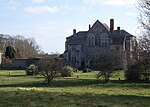Wantisden
Civil parishes in SuffolkEast Suffolk (district)Suffolk CoastalSuffolk geography stubsVillages in Suffolk

Wantisden is a small village and civil parish in the East Suffolk district of Suffolk in eastern England. Largely consisting of a single farm and ancient woodland (Staverton Park and The Thicks), most of its 30 residents live on the farm estate. It shares a parish council with nearby Butley and Capel St. Andrew. It has a church dedicated to St John the Baptist.The place-name 'Wantisden' is first attested in the Domesday Book of 1086, where it appears as Wantesdena and Wantesdana. The name means 'Want's dene or valley'.
Excerpt from the Wikipedia article Wantisden (License: CC BY-SA 3.0, Authors, Images).Wantisden
Orford Road, East Suffolk
Geographical coordinates (GPS) Address Nearby Places Show on map
Geographical coordinates (GPS)
| Latitude | Longitude |
|---|---|
| N 52.110617 ° | E 1.457811 ° |
Address
Orford Road
Orford Road
IP12 3PR East Suffolk
England, United Kingdom
Open on Google Maps











